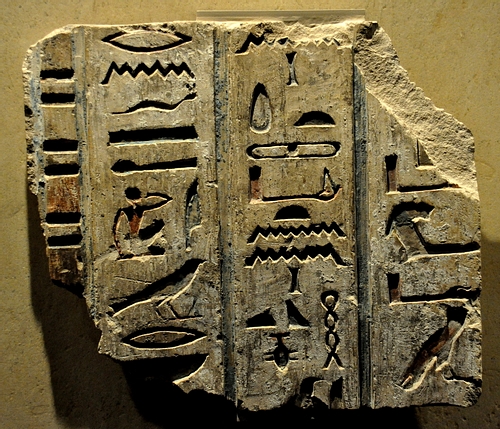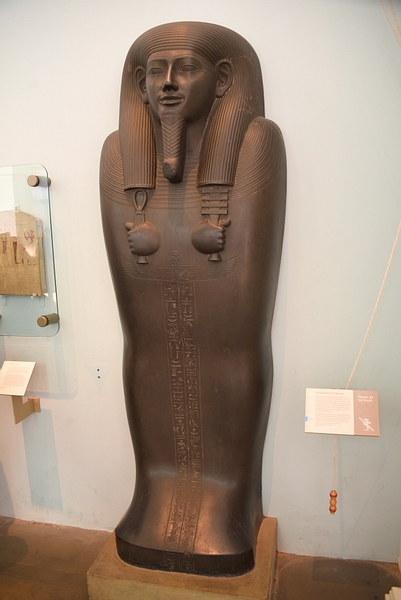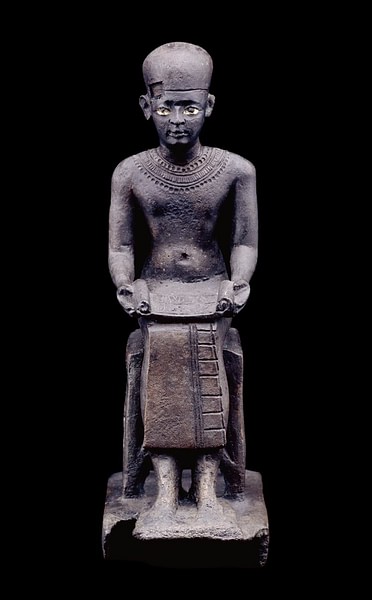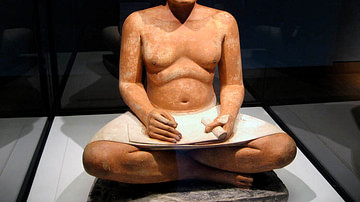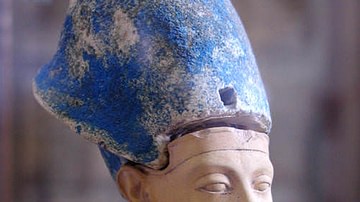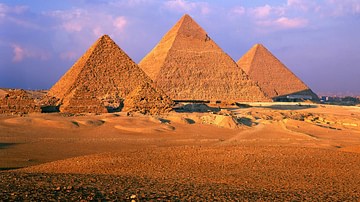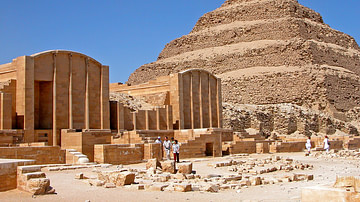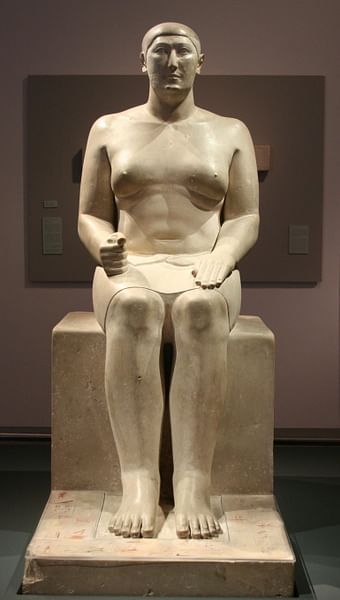
The vizier in ancient Egypt was the most powerful position after that of king. Known as the djat, tjat, or tjati in ancient Egyptian, a vizier was the equivalent of the modern-day prime minister of the nation who actually saw to the day-to-day operation of the government in all its aspects.
The vizier was not simply a counselor or advisor to the king but was the administrative head of the government who implemented the king's policies and arranged for the various governmental departments to carry these out.
The vizier was responsible for the operation of the following governmental agencies:
- Agricultural – Procedures, practices, settling land disputes
- Financial – Taxation, the treasury, and the census
- Judicial – The appointment of the judges and the chief of police
- Military – The appointment of generals and approval of their choices in subordinates
- Architectural – The planning and building of the king's monuments and tomb
- Interior – The planning and construction of roads and repair of dikes, dams, and canals
- Religious – The maintenance of proper rituals and traditions and appointment of high priests
In order to perform his duties, the vizier had to be highly educated and knowledgeable in how all these different agencies worked. The vizier had to be literate, and so had to have received training as a scribe, but also needed the skills of an accountant, architect, lawyer, judge, historian, farmer, and priest.
Egyptologist and historian Margaret Bunson gives an overview of the responsibilities of the office:
Viziers heard all domestic territorial disputes, maintained a cattle and herd census, controlled the reservoirs and the food supply, supervised industries and conservation programs, and were required to repair all dikes. The bi-annual census of the population came under their purview, as did the records of rainfall and the varying levels of the Nile during its inundation. All government documents used in ancient Egypt had to have the seal of the vizier in order to be considered authentic and binding. Tax records, storehouse receipts, crop assessments, and other necessary agricultural statistics were kept in the offices of the viziers. (276-277)
Viziers were originally chosen from among the king's relatives, usually a son, starting in the Early Dynastic Period in Egypt (c. 3150 - c. 2613 BCE). The most famous vizier of this time is Imhotep (c. 2667-2600 BCE) who served under the king Djoser (c. 2670 BCE). Imhotep was an exception to the standard practice of choosing a vizier from the king's family as he was a commoner who achieved his success based on his own accomplishments and personal merit.
Appointment & Character of a Vizier
Imhotep is a rarity among Egyptian viziers, however, and the practice of choosing someone from among the king's relatives – or at least a trusted court advisor – would continue throughout Egypt's history. Viziers were all male with two exceptions, Nebet in the 5th Dynasty of the Old Kingdom (c. 2613-2181 BCE) and another woman in the 26th Dynasty during the Third Intermediate Period (c. 1069-525 BCE). Nebet was the mother-in-law of the king Pepi I and may have only held the title as an honorarium (there is no evidence she actively engaged in administration) and the unknown woman referenced from the 26th Dynasty may have been Nitocris I who was one of the wealthiest and most powerful women in Egypt's history and held the position of God's Wife of Amun but was never a vizier.
In the period of the New Kingdom (c. 1570 - c. 1069 BCE) there were two viziers who served the king – one for Upper Egypt and the other for Lower Egypt – as this was the age of the Egyptian Empire and required more attention to detail. The two viziers were equal in power, prestige, and responsibility. The division of the position into two may also be considered an example of the value the ancient Egyptians placed on symmetry in that Upper and Lower Egypt had long mirrored each other in bureaucratic agencies and even in monuments constructed. The vizier of Upper Egypt, however, would have naturally enjoyed more wealth and power simply because Thebes, where the vizier worked, was one of the richest cities in the country and certainly among the most powerful.
In every period, however, no matter where the vizier lived or how well, the position called for the individual to be honest, to abide by the laws of the country, judge fairly and impartially, and value reason above emotion. Someone given to rash outbursts or emotional responses to situations could not hold the position nor could anyone who might be tempted to show favoritism in a given situation.
The vizier not only dispensed justice but embodied the laws which drew their power from the universal concept known as ma'at (harmony and balance). The concept was personified in the winged goddess Ma'at with her feather of truth. The insignia of the office of vizier, in fact, was an amulet of Ma'at carried on a chain. Even in difficult times, a vizier was expected to uphold and maintain ma'at – just as the king was – in order to ensure that everyone in Egypt, from the highest noble to the lowest peasant, was treated with equal regard under the law.
Duties of the Vizier
A famous vizier of the New Kingdom of Egypt was Rekhmira (also given as Rekhmire) who served under the pharaoh Thutmose III (1458-1425 BCE) and his son Amenhotep II (1425-1400 BCE). Rekhmira is best known for the text Installation of the Vizier (also known as the Instruction of Rekhmira), which describes the duties of the office, how one is chosen for the position, and how one should behave in performing one's duties.

This text, inscribed on the walls of Rekhmira's tomb, tells his life story, how he was given the position by Thutmose III, and how all viziers should serve in office. He emphasizes mercy and compassion for those less fortunate as the most important characteristic of a vizier and provides examples of his own behavior for others to follow:
I defended the husbandless widow. I established the son and heir on the seat of his father. I gave bread to the hungry, water to the thirsty, meat and ointment and clothes to him who has nothing. I relieved the old man, giving him my staff, and causing the old woman to say, “What a good action!” I hated inequity, and wrought it not, causing false men to be fastened head downwards. (van de Mieroop, 178)
The reference to fastening “false men” head downward alludes to the practice of drowning convicted criminals – including those who bore false witness against others – by fastening their hands and feet, putting them head down into a basket, securing the top, and throwing it into the river. The victim would drown quickly – and quietly – as the basket filled with water from the bottom up and when it became water-logged it would sink, taking the criminal to the bottom of the Nile, and thus wiping their name from memory and removing their hope for eternal life as there would be no tomb for anyone to remember them by or leave offerings in.
The severity of punishment was considered just in that everyone understood the basic law of ma'at and the benefits – for everyone – in observing it. The details of Egyptian law are sketchy – archaeologists and scholars still have not been able to assemble a comprehensive document along the lines of the Code of Hammurabi or that of Ur-Nammu – but it is understood that, whatever the details of the law were, they were based on the very simple concept of harmony and balance in one's life.
When a person decided that their needs were greater than those of their neighbor, and acted on that decision to injure another, the person had broken the most fundamental law of the universe and would be punished accordingly. Not everyone who broke every law was thrown into the river or tortured or subjected to amputation of the hand or nose – there seems to have been leniency according to individual circumstances – but generally speaking, if one broke the law in Egypt, one could expect to pay for it dearly.
In addition to handling criminal cases, caring for the needy, and the other duties mentioned above by Bunson, the vizier was also responsible for the military and for the king's grand building projects. The general of the army was ultimately accountable to the king but, practically, reported to the vizier regarding daily operations or campaigns. The vizier often chose a general who then appointed subordinates but those so chosen had to finally be approved by the vizier.
The great monuments of ancient Egypt such as the pyramids and temples were all supervised by the vizier and, in many instances, planned and built directly by them. Imhotep designed and personally oversaw the construction of Djoser's Step Pyramid at Saqqara and Hemiunu, the nephew of and vizier under the king Khufu (2589-2566 BCE), planned and built the Great Pyramid of Giza.
Contrary to popular opinion, the Great Pyramid was not built using Hebrew slave labor. The pyramids of Giza and all other temples and monuments in the country were constructed by Egyptians who were compensated for their efforts. No evidence of any kind whatsoever - from any era of Egypt's history - supports the narrative events described in the biblical Book of Exodus.
Workers' housing at Giza was discovered and fully documented in 1979 CE by Egyptologists Lehner and Hawass but, even before this evidence came to light, ancient Egyptian documentation substantiated payment to Egyptian workers for state-sponsored monuments while offering no evidence of forced labor by a slave population of any particular ethnic group. Slaves in Egypt were either criminals, those who could not pay their debts (or relatives of debtors), or those captured in military campaigns. The kind of skill required to build a monument like the Great Pyramid would not have been entrusted to slaves; they were used in the mines and quarries or for other tasks.
Egyptians from all over the country worked on a king's monument primarily during the months of the Inundation when the Nile overflowed its banks and flooded the fields. Communal building projects employed farmers who would otherwise have been unemployed and also gave work to skilled artists, painters, and masons. All of these workers would have had immediate supervisors but, ultimately, the vizier was responsible for the teams that created the great tombs, temples, and monuments of the Egyptian monarchs.
Famous Viziers
There were many viziers throughout Egypt's history who made important and lasting contributions to the culture but some of them became as famous as the king. Throughout the history of the culture, up through the New Kingdom of Egypt, a vizier made a name for himself through service to the king. The great monuments and temples designed for royalty ensured the immortality of the vizier as well as his master.
As noted, the most famous vizier was Imhotep, an architectural genius and polymath who is also credited with advancing the concept that disease was naturally occurring (not a result of sin) and who wrote medical treatises. He was later deified as a god of medicine and is considered by many in the present day the true “father of medicine” as he lived and wrote long before Hippocrates of Greece.
Hemiunu was the nephew of Khufu who is responsible for the Great Pyramid, the last standing of the Seven Wonders of the Ancient World. Engineers and scholars in the present day still cannot adequately explain how the monument was laid out or constructed.
Ptahhotep I served as vizier under the king Djedkare Isesi of the 5th Dynasty during the period of the Old Kingdom of Egypt (c. 2613-2181 BCE). He is best known for his work The Instructions of Ptahhotep, an important piece of Egyptian literature.
Amenemhat was the vizier under Mentuhotep IV (c. 1997-1991 BCE) who then became king Amenemhat I (c. 1991-1962 BCE, founder of the 12th Dynasty of Egypt and credited with establishing the golden age of Egyptian culture.
Ankhu was vizier under the kings Khendjer and Sobekhotep II of the 13th Dynasty during the early years of the Second Intermediate Period (c . 1782 - c. 1570 BCE) who helped stabilize the government. The kings of the 13th Dynasty were generally weaker and less effective than those of the 12th. Ankhu and his sons (both also viziers) essentially ruled Egypt when the kingship failed.
Aperel (Aperia) served under Amenhotep III (c. 1386-1353 BCE) and his son and successor Akhenaten (1353-1336 BCE). Although he was not responsible for Akhenaten's elaborate new city of Akhetaten (also known as Amarna, which was designed by the king himself), he would have been in charge of Amenhotep III's great building projects (including his mortuary temple and the Colossi of Memnon) and Akhenaten's earlier works.
Khay was vizier under Ramesses II (also known as Ramesses the Great, 1279-1213 BCE). He was a favorite of the pharaoh who elevated him to the level of his own sons. Khay, as vizier, would naturally have played an important role in any official festival but seems to have held a more prominent place than others before and after him. Khay would have been responsible for the successful public relations initiatives for his king. His success in this is made clear by the fact that there is no ancient site in Egypt which does not mention the name of Ramesses II.
Conclusion
These viziers and their accomplishments are only a very small sample of the many men who held the position and ran the country throughout Egypt's history. The office continued to be filled by those considered the best men of their time through the Ptolemaic Dynasty (323-30 BCE), the last to rule Egypt before it was annexed by Rome and became a province of the Roman Empire. Unfortunately, some of these men gave in to the pressures and temptations of their time and viziers were often corrupt toward the end of the New Kingdom, when society had lost its balance, and in the eras which followed. For most of the country's history, however, the vizier took his responsibilities seriously and performed his duties faithfully.
In the present day, people commonly recognize the image of the pharaoh as a symbol of leadership in ancient Egypt and the office of vizier is relegated to the status of an advisor to the king or high-level bureaucrat. In reality, the vizier ran virtually every aspect of the Egyptian government for over 3,000 years and sometimes, as in the case of Ankhu, took direct control of leadership and reigned as king. Although the famous monuments and tombs of Egypt are identified with the monarchs these men served, they would not exist – or, at least, not in their present form – without the impressive talents and skills of the king's vizier.
